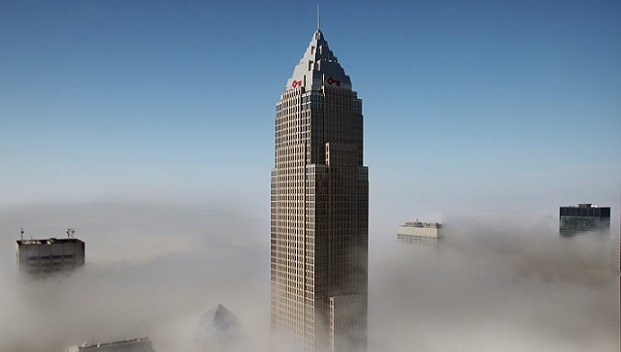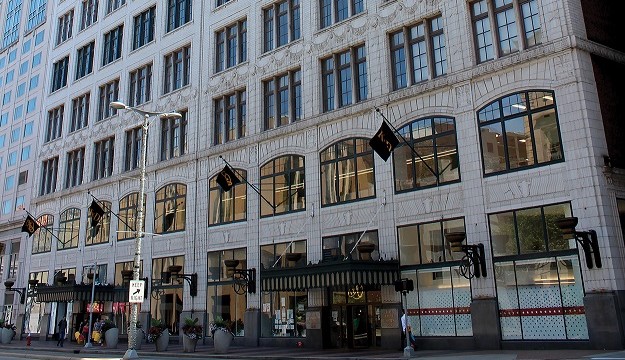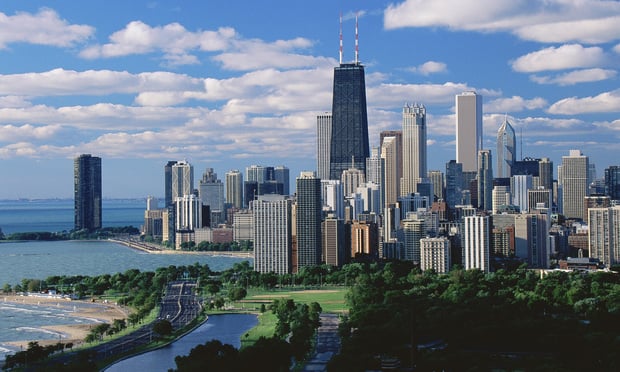 Key Tower in Cleveland, the city's most notable office property, commands the highest rents and has a vacancy rate in the single digits.
Key Tower in Cleveland, the city's most notable office property, commands the highest rents and has a vacancy rate in the single digits.
CLEVELAND—Starting in the 1970s, the downtowns of major cities across the US went through a few tough decades as corporations fled to suburban office campuses and the streets got quiet after sundown. But many CBDs, especially in the Midwest, recently grew more attractive to both users and investors.
Cleveland is one of the best examples of an older industrial city finding new life. The migration to its suburbs reversed in the past five years, and developers have created thousands of new, well-occupied apartments out of obsolete office space. In their wake, retailers opened up shops and grocery stores. New entertainment options and amenities have also flourished.
“All the dynamics you look for in a vibrant central business district exist here,” Scott Pick, a managing director of JLL's Great Lakes Region, tells GlobeSt.com. That fact is not always appreciated in the national media, but the company's new Cleveland Skyline Review, which presents detailed statistics on the CBDs top 40 office properties, may help change the conversation.
“It shows demand is over weighted significantly toward trophy and other class A assets, largely because companies are hyper-focused on recruitment and retention,” Andrew Batson, JLL's vice president of research, tells GlobeSt.com. Of the roughly 2.5 million square feet of class A space, just 13% remains vacant. “That's a very healthy vacancy rate, especially for a secondary market in the Midwest.”
JLL classifies Key Tower, Ernst & Young Tower and 200 Public Square, which together total nearly 3.2 million square feet, as trophy-class buildings, and due to advanced technology and full suites of amenities, these premier office properties fare even better. The vacancy rate for this set now stands at just 9%. At 5%, the Ernst & Young building, completed in 2013, has the lowest rate among the three. And with a $32.00 average, it ties Key Tower for the city's highest asking rent.
Those vacancy rates have fallen partly because suburban firms increasingly see downtown as a viable option. When it comes to attracting suburbanites, “some cities like Chicago are a few years ahead of us,” Batson says. Still, JLL found 25 Cleveland-area companies that made the switch in the past five years, bringing more than 2,000 jobs to the city and absorbing about 500,000 square feet of space.
Pick also believes this trend will continue. “If you look at the suburban office markets, there is a limited availability of large blocks of quality space.”
 The Halle Building in Downtown Cleveland
The Halle Building in Downtown ClevelandBut by far the most significant recent change in Cleveland has been the transformation of many class B and C buildings. In the past decade developers converted 18 functionally obsolete and underperforming office buildings to residential and hotel use, according to JLL. That took more than 4.5 million square feet of office space offline.
The Halle Building, for example, an 11-story, 172,000-square-foot building, was at one point about two-thirds vacant, Batson says. But after converting six floors to residential, the office portion of the once-stagnant property is 100% occupied. Likewise, the 14-story base of Terminal Tower, Cleveland's second-tallest building, was converted to residences, and the office portion now has a vacancy rate of 4%.
“It really improved the fundamentals from an investment standpoint,” Batson says. “It also helped bring more residents into the city,” and that kind of activity, which always means more retail and entertainment, attracted yet more office users. “One trend is feeding off the other.”
In 2014, Skokie, IL-based American Landmark Properties Ltd. acquired 1111 Superior for a low price, when the 28-story tower was only 53% occupied. Within its first year of ownership, American Landmark renovated the lobby, added an executive fitness center and conference facility, and boosted occupancy to nearly 80%.
The biggest deal of all was in January 2017, when local firm Millennia Cos. purchased Key Tower for $267.5 million. “They put a significant amount of investment into the building,” Pick says. Soon after, Millennia signed Forest City Realty Trust, Inc., which moved from Terminal Tower, to a major lease and “put its vacancy into single digits.”
“We don't see things slowing down through the rest of the year.”
© Touchpoint Markets, All Rights Reserved. Request academic re-use from www.copyright.com. All other uses, submit a request to [email protected]. For more inforrmation visit Asset & Logo Licensing.







